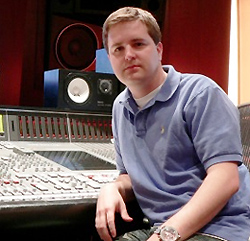Andrew Dawson is a Grammy-Award winning engineer and producer. A fast rising-star on the scene, Dawson’s credits include Kanye West, Common, T.I., Jay-Z, Destiny’s Child, Lil Wayne, Drake, Rick Ross, Erykah Badu & more.
He’s been the primary tracking & mix engineer for the last four Kanye West albums, including the latest, “My Beautiful Dark Twisted Fantasy.” He kindly took time out of his busy schedule to speak with me – engineer to engineer – discussing his history, his approach, and the future…
Enjoy!
—-
You’re living in LA now, but you are originally from Minnesota.
I’ve been living in LA for 3 years now. I went to Berklee in Boston, and lived in New York for 6 years working at Sony, Hit Factory, Quad, and Legacy. All of those spots started closing down, and it’s too freaking expensive to live there. I was thinking that I was going to move to LA more and more.
I understand the feeling, but it’s intimidating to make that kind of move. Did you have any leads?
I had been freelancing since I was like 23. The numbers just started making sense to go freelance. When I moved out here, I never really had problems getting work. Once I made the decision to move, I was out here a week later working with Common! LA’s awesome.
What I’ve been able to do in LA – what a lot of the mixers are doing now – is have my own facility on Sunset, two blocks away from Hollywood Highland. It’s not like I’m going to track orchestras in there, but it works. It’s about 1100 sq ft, has a nice lounge etc… that would be like ten stacks a month in NY. I’m in the heart of it all. People are cool with stopping by my studio to work, and I don’t have to drop 2 grand a day on a big room. It allows me to mix at a comfortable pace. With my clients, I charge my fee and a facility fee. The facility fee simply covers my overhead costs.
Let’s talk about your professional path. What was the route?
I’ve been working at studios and doing live sound since high school. I was doing outdoor concert festivals – 500 to 600 people a day. I don’t know why anyone would hire me at 16, but I did FOH – large shows with 5 monitor mixes and such. I worked in a studio as a coffee boy even before attending Berklee. I did a lot of live sound for summer tours. While attending Berklee, I worked for Lexicon. When I left, I interviewed at the Hit Factory and Sony Music. Because of the live sound stuff and the Lexicon gig, I was like, I don’t want to be an intern – I kind of want to start as an assistant. The studio manager said if I can get down here and learn the rooms, I’d have a chance.
I literally moved from Boston to NY in a week, took the job at Sony Music Studios and in 2 or 3 months I was assisting. At that place they had 7 mixing rooms, 4 mastering rooms, sound stage, tie lines between everything, 2 inch tape reels, Pro Tools. If I couldn’t handle that, I was toast. It was probably the hardest place to work as an assistant engineer. It was awesome being able to work there though. I never became anybody’s regular assistant, but I worked with guys like Bob Power and Tony Maserati. I remember learning a lot from Dexter Simmons too.
Do you mix with an intern or assistant now?
I mix completely by myself. I prefer to mix by myself. In my studio, I have the space for a board, but didn’t put one in. It’s a production/mixing room that looks almost like a mastering facility. I’m mixing ITB, then using some analog gear and summing mixers – the hybrid system.
Tell me more about your work with Lexicon.
I worked with Lexicon during my last two years at Berklee. I started off as an alpha tester, they brought me in to break their gear. I would try updates, going through every single patch and preset. Then I worked in their marketing department, and also did the delay presets for the 960L. I don’t have a 960L – maybe they’ll give me some kind of retro deal.
I know asking this is like asking to pick your favorite kid, but what’s your favorite mix?
A producer asked me the other day what songs I had mixed. I had to pause and think; I couldn’t remember. I started flipping through my catalog and came across Common’s record “So Far to Go” on Finding Forever. I like that one because that song is out on J Dilla’s album, but I did my own take on it. The other was esoteric, which was cool, and mine was super boom bap. It was cool getting to do my own take on it. Kanye’s “Gone,” a lot on Late Registration – “Crack Music” has a big horn section and strings, it was a big production and I had to mix everything together to make it work.
.
Ok – now, I’m going to pick my favorite Andrew Dawson mix. My personal favorite is “Be,” not just because it’s a great mix, but because it’s so unpredictable. In a traditional Hip Hop mix, the vocals, drums, and bass will be right upfront – and the synths will sit in the background. Here, you have the bass in the middle of the room, and the synths are super dry and upfront.
Interestingly enough that was how the bass was recorded. I didn’t close mic it at all – I had one mic 8 feet back. It was all in the tracking – no eq no compression. that’s just straight in. I liked it so that’s how it stayed. The synths were super dry to contrast the bass.



















